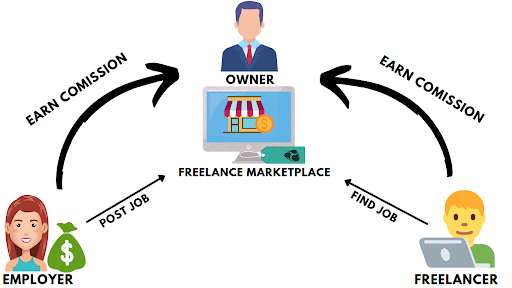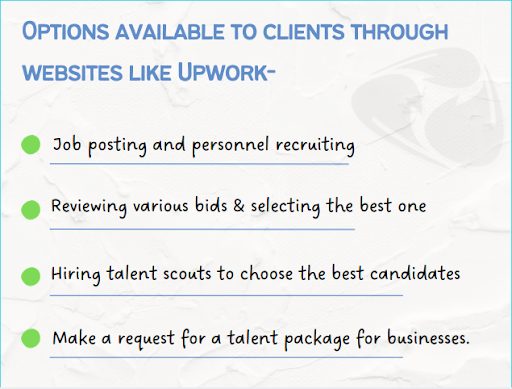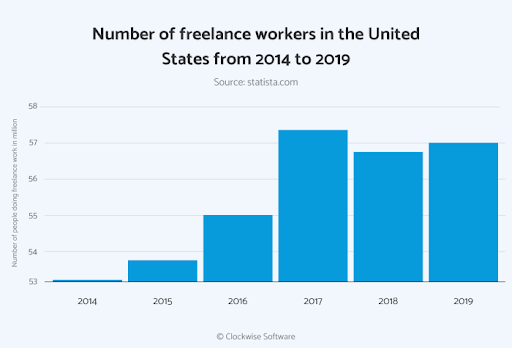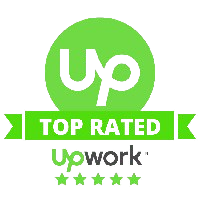Building an online freelance marketplace like Upwork or Freelancer
Table of Contents
Introduction

Request a No-Obligation free consultation

What Is A Freelancer Marketplace And How Does It Work?
A freelancing marketplace is a two-way platform where businesses can discover and employ particular specialists for specific assignments, and freelancers may apply for available positions if their abilities fit the requirements. Contractors collaborate with their supervisors remotely.
Why Are These Marketplaces So Popular?
A freelancing marketplace is a two-way platform where businesses can discover and employ particular specialists for specific assignments, and freelancers may apply for available positions if their abilities fit the requirements. Contractors collaborate with their supervisors remotely.
- This is an endless supply of talent: organizations may locate a wide range of experts with extensive expertise from all around the world.
- This is a very practical method of hiring a candidate: after filtering, shortlisting, and testing, a company may begin working with the ideal contractor.
- This is a basic time-tracking tool: once an employer hires an expert, he or she gets accurate data on how much time was spent on a certain activity;
- This is a platform with a built-in payment mechanism, which allows an employer to pay a contractor directly from the platform when the project is completed.

Today, we’ll take a deeper look at some of the most popular freelancing marketplace platforms like Upwork.com and Freelancer.com.
Freelancer.com has been around for over a decade, has over 180 job categories, and over a million members, making it the world’s largest talent marketplace. Freelancer is extremely appealing to customers and self-employed individuals due to the size of the marketplace and the variety of possibilities accessible. Due to the platform’s compatibility with the majority of prominent payment systems, there are several payment choices accessible. Clients must manually wade through profiles of less-skilled individuals on the downside, and the hiring fee is greater than on Upwork. If an independent contractor completes more than eight projects in a month, they must pay a charge.
Features of a Freelance Marketplace like Upwork and Freelancer
- Registration and authentication (Social logins)
- User profile management
- Job search system
- Comission based payment integration
- Freelancer/Agency search system
- Workroom and instant messaging
- Review and feedback system
A Roadmap To Developing A Freelancing Website

1. Pick a business specialization.
It’s a fair idea to target a specialized market. It’s impossible to create a product that caters to everyone. Find your target market and design your product to meet their wants. A few instances of such an approach are as follows: 99designs caters solely to designers, whereas Fiverr was founded with the goal of providing low-cost (beginning at $5) and quick freelance services.
2. Create a Revenue model.
Before you start building a freelancing marketplace, you need to figure out how you’ll make money. The primary means of generating income comprise the following:
– Selling fees or commision
– Subscription model
– Payment processing and transaction fees
– Sponsored features
– Ads from 3rd party advertisers
3. Define your specifics
Listing down your expectation is a good start for any project. Before you get into the design and development, you must first determine exactly what is required. In the long run, this will save you a lot of time and work.
4. Create a design
It’s time to create a visual brand and user experience for your online freelancing marketplace. There are generally numerous steps to the UX/UI design process:
– Trend and Market analysis
– Mockups and wireframing
– Design and UI/UX
5. Creating a prototype
You may see your product in action or even test it with actual people as soon as you have the visual design. Rapid prototyping comes into play at this point. It doesn’t take as much time (or money) as development, but it’s incredibly useful for confirming your assumptions early on in the process.
6. Growth of the marketplace
You can now convert your visual design and UX into code and develop a marketplace website after you’ve built, tested, and polished them. If you don’t have an experienced CTO on your team, we recommend hiring a dedicated development team from a reliable technology supplier. Your team will assist you in selecting the best technology stack and defining the bare minimum of functionality, to begin with.
7. Testing and QA
Despite the fact that we discussed testing after the development stage, they frequently happen at the same time. Tests are sometimes written before the code is written (in the case of Test Driven Development). However, regardless of your strategy, quality assurance is a must if you want to create a working and profitable marketplace.
8. Product release and continuous improvement
After you launch your marketplace website, the work doesn’t stop. You must concentrate on enhancing and scaling your product. There’s always something you can improve on, and there’s always room for improvement.
Have a project that you would like discuss?
Free project quote
Please fill out the enquiry form below and we’ll establish communication with you as soon as possible

Lee Zinser
Founder at Needgr8r
"Team is great to work with.. They get what you need and action it with great results. Him has worked with us for a few years on various web related projects.. They are problem solvers and give valuable suggestions regarding the project. They are very fair and work fast. We are using them on continued projects. Thanks!"
Source: Upwork.com
Add Your Heading Text Here


Choose The Appropriate Technology Stack
Let’s take a look at some of the programming languages, frameworks, and tools available for creating a freelancing marketplace website.
- Backend - Upwork have PHP and Java as their programming languages of choice. Other technologies, such as NodeJS, Python can also be used instead. They're a fantastic fit for initiatives involving the creation of online marketplaces.
- Front-end - Angular.js and Bootstrap were chosen by Upwork. React, Vue.js are other front-end frontend frameworks that are very popular today.
- Database - A traditional relational database is recommneded a marketplace. MariaDB and PostgreSQL are open source options available.
- Cloud Infrastructure - Dedicated VPSs are always recommeded for project like these. AWS is first choice followed by Google Cloud and DigitalOcean
Where Do You Begin?
The best way to establish a solid foundation for the growth of your online marketplace is to start with product discovery. It contains a functional specification, UX/UI design, and a visual prototype to give you a clear idea of what the final product will look like. This stage usually takes 4-6 weeks.
You may use the product discovery phase to:
- Develop a strategy for developing a marketplace by defining the complete scope of activities.
- Plan your resources and create a realistic budget for your MVP.
- Use a visual prototype to test the waters with your audience and shareholders.
- Create a persuasive investment proposal
- Gather a team with diverse skillset
Tips To Keep Your Freelance Marketplace Competitive
- Perform a comprehensive market study.
- Learn as much as you can about your target audience and their requirements.
- Determine your distinct selling point.
- Consider a variety of company models.
- Focus on solving problems that your audience is facing
Conclusion
We hope you found our step-by-step guide on creating an Upwork-style website useful. Please do not hesitate to contact us if you have an idea for a freelancing marketplace.
For many years, the JustAddWater team has been working on bespoke online marketplace construction. We will gladly accept your project.





